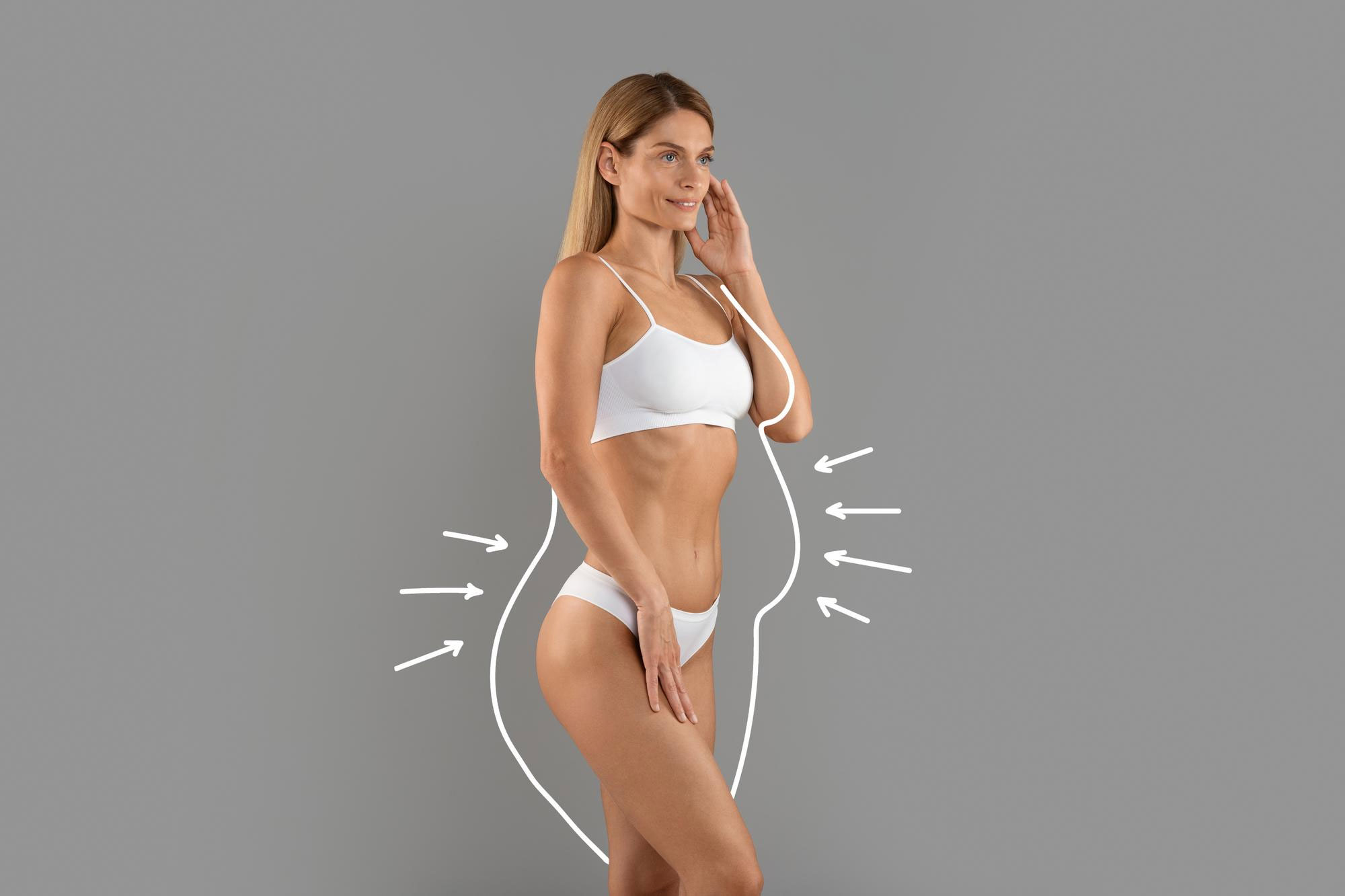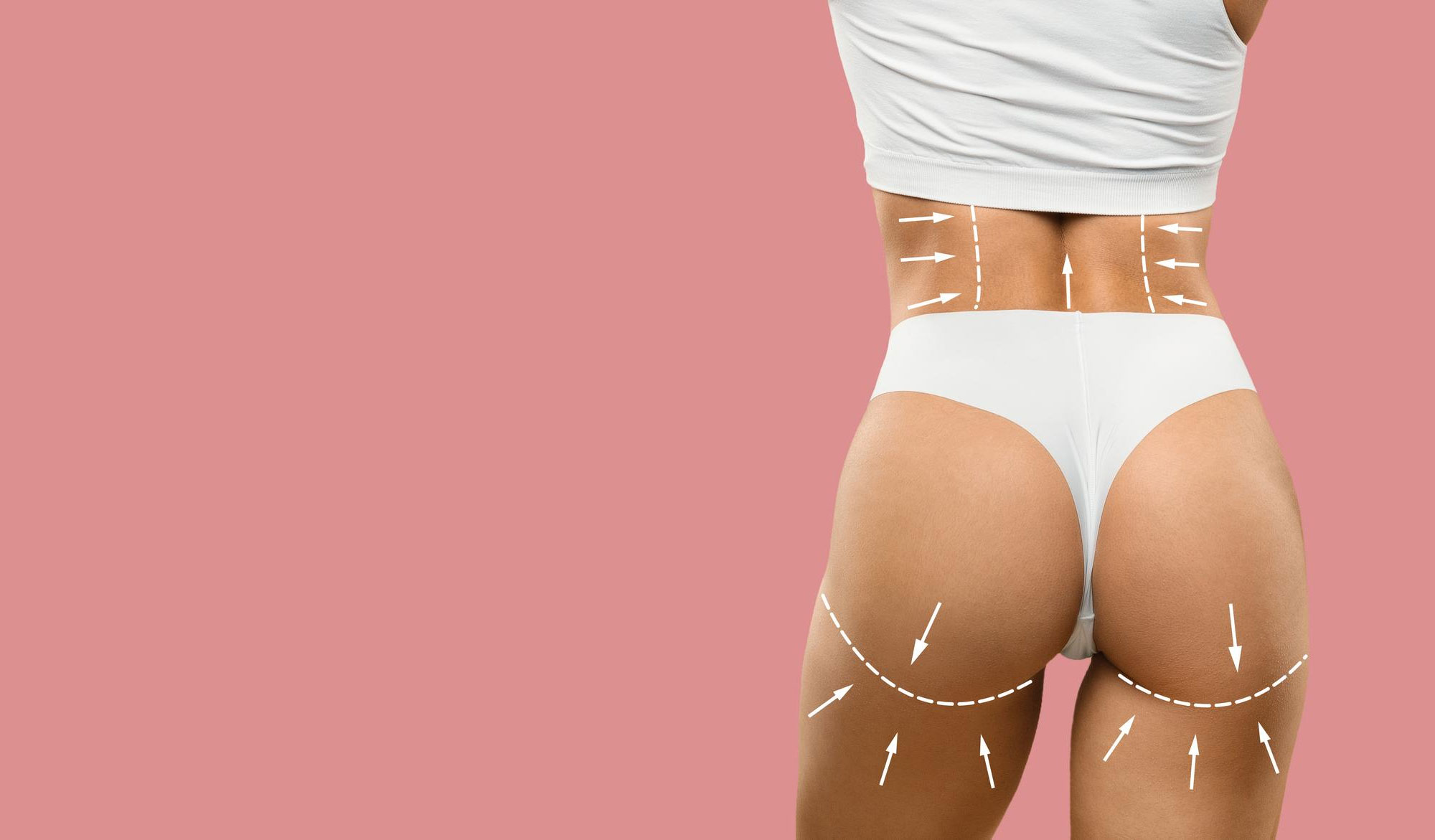What Exactly is Liposuction?
Liposuction is basically the process of surgically removing fat tissue accumulated in certain areas from the body. The "subcutaneous fat tissue" located just below the body, between the skin and the muscle layer is targeted. With the help of thin, long and hollow cannulas (tubes) used during surgery, unwanted fat cells are pulled out as if they were vacuumed.
Sometimes this method is also called "lipoplasty" or "fat removal surgery". The most common areas of application include the abdomen, waist, hips, thighs (upper legs), arms, under the chin (double chin) and even the back.The aim is not to lower the body mass index to a cliff; the main goal is to shape the fat pockets that stubbornly won't go away and achieve a proportional appearance.
To use an analogy, we can liken liposuction to weeding unwanted weeds in a garden. Although the garden does not change completely, the unsightly excesses are removed and a smoother landscape emerges. Therefore, liposuction is not a weight loss method, but a shaping and correction approach.
Why Diet and Exercise alone are not enough?
In fact, most of the time, a healthy diet and regular exercise are the primary means of maintaining our body's natural balance. But sometimes, no matter how much exercise we do, fat accumulation in areas such as the belly or hips can remain stubbornly. This can be due to genetic predispositions, hormonal factors or metabolic rate. For example, some people are more prone to storing fat, even if they eat the same amount of food.
Diet and exercise can reduce the body's overall fat percentage. However, burning fat regionally is not as simple as instructing the body to "Burn the fat in this area". For this reason, liposuction can be seen as a complementary method to eliminate stubborn fat clusters that cannot be controlled with diet and exercise.
To explain with an example: A person who does regular sports but only complains of a bulge in the abdominal area can make the abdominal muscles more prominent thanks to liposuction. The rest of the body is already fit, only that regional fat mass is disrupting the big picture.
Who Can Liposuction Be Applied to?
Liposuction is not a treatment for obesity. If the person has serious weight problems and the body mass index is very high, weight loss programs are considered first. Liposuction is mostly recommended for people who are close to their ideal weight but have regional adiposity problems.
Body Weight: It is generally appropriate to be a maximum of 20-30% above the targeted weight range.
Skin Elasticity: After the procedure, the skin is expected to firmly adapt to the new contours. This adaptation is easier especially in young patients. Skin elasticity may decrease with advancing age or after pregnancy.
General Health Status: People with chronic conditions such as heart disease, diabetes, etc. may be at increased risk of surgery. In addition, the procedure may be postponed if there is a bleeding disorder, active infection or immune system problems.
Realistic Expectations: Liposuction is not a "miracle surgery" but a contouring aid. It is important that the person has realistic goals regarding his/her postoperative appearance.
As a result, the doctor's assessment determines whether the person is the right candidate for liposuction. In summary, anyone who is healthy, within a certain weight range, has a skin structure suitable for tightening and keeps their expectations at a reasonable level can be a good candidate.
Which Techniques Are Used During Liposuction?
Although a single method comes to mind when it comes to liposuction, there are actually more than one technique. The method to be used varies depending on the needs of the patient and the experience of the surgeon. Sometimes various techniques can be used complementary to each other.
Suction-Assisted Liposuction (SAL)
This method is also known as "classical liposuction". The vacuum system, which works just like a vacuum cleaner, pulls the fat with the help of a cannula. The cannula tip is moved in various directions to avoid blockages or to loosen fat faster.
Power-Assisted Liposuction (PAL)
This technique supports the traditional method with a more powerful vibrating mechanism. Since the tip of the cannula is vibrating, it is easier to break down the fat in stubborn and hard areas. In this way, the surgeon's physical effort is reduced and the procedure can become more controlled.
Ultrasound-Assisted Liposuction (UAL)
This is where ultrasound waves come into play. The ultrasound waves transmitted on the cannula or with the help of a special probe liquefy the fat cells. It is then easier to vacuum them out. It is especially effective in fibrotic areas with very hard tissue.
Laser-Assisted Liposuction (LAL)
Laser technology breaks down the membranes of fat cells and melts the fat. While the melted fat is removed from the body, the laser heat can also contribute to skin tightening by stimulating collagen production in the lower layers of the skin.
Tumescent Liposuction
It starts by injecting a solution called tumescent fluid, which is a mixture of local anesthetic (lidocaine), saline and blood vessel constrictor (epinephrine), into the fat tissue. This fluid swells the fat tissue, making the procedure easier. It reduces bleeding and supports pain control.
Water (Water)-Jet Assisted Liposuction (WAL)
A pressurized water spray system loosens the fatty tissue and simultaneously suctions out the fluid and fat particles. It is a particularly gentle approach, with less potential to damage the tissues.
Each technique has its advantages and disadvantages. While skin tightening may be evident in some, the recovery period may be shorter in others. The technique to be used is usually determined according to the structure of the adipose tissue, the amount of fat to be removed and the characteristics of the targeted area.
How to Prepare Before Surgery?
Liposuction is ultimately a surgical procedure and some preparations are made before the operation. This process is aimed at minimizing possible risks and making the healing process more comfortable:
Blood tests and examination: It is checked to see if there is a condition that may prevent the operation. Especially coagulation values, blood count, kidney and liver function tests are important.
Smoking: Smokers are advised to quit smoking for a certain period of time before surgery. Because smoking delays tissue healing and increases the risk of infection.
Blood thinners: Aspirin, some herbal supplements and vitamins can increase bleeding. Their use should be discontinued some time before the operation.
Nutrition and Hydration: Water consumption can be increased and a balanced nutrition plan can be followed to help the body respond better to the stress of surgery and recovery.
Realistic Expectations: Getting detailed information about the postoperative appearance and process before the operation puts the person's expectations on the right ground.
These preparation stages are actually a bit like "packing your luggage before traveling". Thanks to well-planned and complete preparation, the journey (i.e. surgery and recovery) will be more comfortable.
How is the operation performed?
Liposuction is performed in a hospital or clinical setting, usually under anesthesia. The type of anesthesia may vary depending on the amount of fat to be removed and the area:
If it is a small area, local anesthesia may be sufficient.
Sedation (drowsiness) can be added in moderate areas.
General anesthesia may be preferred in large areas.
Then the following steps are followed:
Tumescent Solution Application: Liquid is injected into the fat tissue, which reduces bleeding and pain.
Making Small Incisions: Tiny holes of 2-3 mm are made. These incisions allow the surgeon to insert the cannula easily.
Dissection of Fat Tissue: Fat cells are broken down according to the preferred technique. Sometimes simple vacuum, sometimes ultrasound or laser is activated.
Removal of Fat (Aspiration): The broken fat cells are removed from the body with the help of vacuum.
Closure and Compression: Since the incisions are very small, they are usually managed with a few stitches or self-closure. An elastic bandage or a special corset is then applied to the area.
The duration of surgery may vary depending on the size of the target area and the choice of technique. Some patients may be discharged on the same day, while others may need to be kept under observation overnight.
What is the Recovery Process?
The healing process after liposuction varies from person to person. However, pain, bruising and swelling are generally expected in the first days. These are natural reactions of the body after surgery and usually resolve within a few weeks.
Pain and Bruising: The pain is usually mild or moderate; painkillers can be used upon physician's recommendation. The color of the bruises changes over time to pink, purple, yellow-green and disappears.
Swelling and Edema: Most swelling subsides within the first few weeks, but sometimes it is necessary to wait several months for full results.
Compression garment: Special corsets or elastic bandages are used to maintain the new form of the liposuction area, reduce edema and ensure skin adaptation. It is recommended to wear this corset for a certain period of time for most of the day.
Activity and Exercise: Rest, light walking and drinking plenty of water are generally recommended for the first few days. It is important to avoid heavy exercises and intense physical activities for a while. The surgeon usually allows a gradual return to sports within 2-4 weeks.
Doctor Checks: Check-ups are done at certain intervals. During this process, stitches may be removed or openings checked; regular follow-up is also important for early detection of any complications.
The most important tip during the healing process is not to push the body too hard. Just like treating a newly planted sapling gently; it is necessary to allow the body to recover.
Is It Possible to Achieve a Permanent Result?
Fat cells removed from the body with liposuction do not return; because the number of fat cells in the body of adults is usually constant. However, this does not mean that weight gain will never occur. If the person eats unhealthy and remains sedentary after the operation, the remaining fat cells may grow or fat may increase in other parts of the body.
For this reason, it is important to regain a balanced diet and regular exercise habits after the procedure. Seeing the surgery as a step that supports a healthy lifestyle, without seeing it as a "magic wand", brings happier and lasting results in the long run.
Another garden example can be given here: Even if we remove the unwanted weeds in the garden and plant beautiful flowers, if we stop caring and neglect the soil, the weeds may sprout again from another corner. In the same way, we should think of the body as a garden in need of regular maintenance.
What are the Complications and Risks?
Liposuction can generally be considered safe when performed with modern surgical methods. However, as with any surgical operation, there are risks and rare complications:
Infection: Although not very common, there is a risk of bacterial growth in the treated area. It is minimized with antibiotic protection and hygiene measures.
Bleeding and Hematoma: Small bleeding and bruises can be expected after surgery. Although large hematoma (large accumulation of blood under the skin) is rare, it requires serious follow-up.
Seroma (fluid accumulation): Fluid may accumulate in the empty cavities. In this case, the fluid may need to be drained with a syringe.
Skin Irregularities and Ripples: Especially in areas where a lot of fat is removed, if the skin is loose or depending on the technique, a wavy appearance may occur.
Liponodules or Cysts: Small hardnesses may remain in the fatty tissue. Most of the time, these hardnesses soften with massage and time.
Fat Embolism: It is a very rare complication; it occurs when fat particles enter the bloodstream and block the lung or brain vessels. It requires rapid intervention.
Lidocaine Toxicity: Lidocaine used in tumescent fluid may cause toxicity if given in excessive amounts. However, this is very unlikely in experienced hands.
Having an experienced plastic surgeon perform the operation and providing the appropriate medical environment significantly reduces the risks. In addition, spending the postoperative period in accordance with the recommendations minimizes the possibility of complications.
When Can I Return to Daily Life After Liposuction?
Many people wonder how soon they can return to work or social life after liposuction. This time depends on the extent of the procedure. After intervention in a small area, some patients can return to their desk jobs within a few days. For larger areas, this may take more than a week.
First Days Rest and light walks.
Within a Week: Stitch checks, discoloration of bruises, partial reduction of swelling.
Between 2-4 Weeks: Start light exercises, more participation in daily routine.
6 Weeks and After: Most patients can return to their normal sports routine. The use of the compression garment is also gradually reduced during this period.
Of course, these periods are generalizations. Each person has a different healing speed, pain tolerance and body reaction. If the recovery is slow or fast, it does not mean that the surgery has failed; each body has its own pace.
Can Other Aesthetic Procedures Be Performed Together with Liposuction?
While liposuction alone is sometimes sufficient for body shaping, it can sometimes be combined with other interventions. For example:
Tummy Tuck (Abdominoplasty): It can be combined with liposuction to remove excess skin in the abdominal area and tighten the muscles. It offers an effective solution especially for people with relaxed abdominal muscles after pregnancy.
Breast Aesthetics: It can be applied together with breast reduction, augmentation or lift operations.
Facelift: While the fat tissue on the face is removed, the jowl line can be thinned with liposuction of the neck area.
Butt Aesthetics (BBL, etc.): Fat extracted from the abdomen or waist can be injected to shape the buttock line.
However, combined procedures always mean longer surgical time and a more extensive recovery period. The surgeon's assessment is therefore very important, taking into account how many procedures the body can handle at one time. More procedures mean more care and risk management.
What are the Long-Term Healthy Living and Control Recommendations?
Maintaining the results achieved after liposuction depends entirely on personal habits. The surgery corrects the contours, but does not completely prevent future fat deposits. The ideal is to see this intervention as an opportunity and to make a healthy lifestyle permanent.
A balanced diet: A diet rich in protein, fiber and healthy fats and low in sugar and refined carbohydrates is recommended.
Regular Exercise: Moderate-intensity exercise at least 2-3 times a week is important for both cardiovascular health and weight maintenance.
Adequate Water Consumption: Body fluid balance affects many factors, from fat metabolism to skin health. Drinking at least 2 liters of water a day is usually sufficient.
Stress Management and Sleep: Good quality sleep supports weight control by helping hormone balance. Stress can cause emotional eating and hormone disorders.
Periodic Doctor Checks: Periodic doctor examinations in the postoperative period are beneficial in terms of both general health and observation of aesthetic results.
While a healthy lifestyle helps to maintain the results of liposuction in the long term, it also gives the person a better mental and physical health in general.


















